Вестник Пермского университета. Серия: Экономика @economics-psu
Статьи журнала - Вестник Пермского университета. Серия: Экономика
Все статьи: 717

Статья научная
The development of Russia's economic strategy due to the balance of current and long-term challenges, when current ones must be subordinated to established long-term tasks is discussed in the study. The strategy content is often replaced solely by current tasks, the way the macroeconomic policy should be arranged, whether privatization should be carried out, monetization should be increased at the expense of target emissions, and to what extent inflation should be suppressed. These issues being significantly important in the current regime, nevertheless, do not give a strategic vision of what the economic system should become. The current policy instruments that are collectively referred to as strategic programs are broadly discussed. At the same time, the main reasons why the economy is in such a condition have not been analyzed yet. Another issue concerning the failure of the previous programs which have been earlier discussed has not been settled yet. The root of the problems is in the organization of the economy, its structural features and the already introduced new system of basic institutions, and the permanent correction of these institutions does not work for the benefit, even hinders economic development, as it forces agents to relentlessly modify adaptation models. The content of the development strategy must include the essence and ways of changing the economic structure so that this change reproduces new factors of its growth. Otherwise, economic growth will be based on the previous factor model, which the growth of 2017 demonstrates. The specifics of Russia's technological development have already been revealed under the new modernization priorities, the need for a radical change in the methods of the current macroeconomic policy for monetary and budgetary direction has been shown. A methodological framework for the formation of a strategic program that is useful for the work of the analytical services of the Russian government has been considered. The management of structural changes requires the organization of a model of intersectoral mobility of resources that takes into account the task of new markets formation and priority areas of technological development. The mobility will bring additional resources for industrial economic growth as excess resources (capital and labor) are concentrated in transactional and resource sectors. Thereby the strategy of Russia's economy development requires measures that influence the proportion changes among sectors. This interaction is provided by changing of risks in economic activity in economic sectors and differentiations in monetary policy, in particular interest rates as a key tool of the policy. We suggest correcting a model of transmission mechanism of a macroeconomic policy that is considered to be a tactical method to solve strategic tasks of development. A systematic increase in the monetization of the economy and a differentiated percentage of investment projects by sectors are the main prerequisites for a new model of macroeconomic growth policy in Russia, where structural policy becomes the main element.
Бесплатно

Статья научная
The question of whether the strategy of undertaking corporate social responsibility (CSR) policy is an effective signal of a high level of food safety is considered in this paper. Despite the existence of some state mechanisms aimed at solving the lemon problem, the presence of a great number of fake and adulterated food on Russian food markets show that it has not been solved yet. Specificity of food (its experimental and trusting qualities) makes it impossible to evaluate the qualitative characteristics of food before it is purchased by customers. The analysis was based on Bertrand model with a differentiated product. Theoretic and game modelling resulted in articulation of the conditions for "desired" Nash equilibrium, where CSR policy is implemented by the companies producing safer food. The comparison of possible Nash equilibriums has lead us to the conclusion that the efficiency of CSR strategy as a quality signal is determined by the control and support of the manufacturers provided by the state and by the number of "responsible" health-conscientious customers. "Desired" Nash equilibrium may be reached without "responsible" customers, but with a high level of state support towards "honest" companies with a positive CSR record. This means that the weakness or lack of state mechanisms to support or encourage the manufactures, a small share of health-conscientious customers, their low activity in monitoring safety level when choosing food are among the factors determining the low activity of manufacturers in CSR policy implementation.
Бесплатно
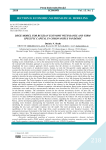
DSGE-model for Russian economy with banks and firmspecific capital in coronavirus pandemic
Статья научная
The article presents a dynamic stochastic general equilibrium model (DSGE-model) for the Russian economy. The model describes the behavior of the following macroeconomic agents: households, real sector, banking sector, Central Bank, as well as the interactions between them and the world. Household modeling uses the external habit formation approach to account for the inertia of preferences. To model the real sector, we abandoned the most common approach which assumes that the decision on investments is made by the households as the owners of production factors. Instead, we took the firm-specific capital approach which assumes that the decision on investment is made by the firms themselves. The study also considers that in Russia, fixed assets are mostly invested from the firms' own funds. To account for the investment inertia in the fixed asset in a real sector model, the expenditures are transferred to the commissioning of new facilities, the Calvo model is applied to describe the price setting under the monopolistic competition. A banking sector which defines the loan and debt interest rates to the key Central Bank interest rate is chosen to be a link between the households and firms in the model. The Taylor equation is used to describe the monetary policy of the Bank of Russia under the inflation targeting, while an inertia factor is included into the equation with the uncovered interest parity for the budget rule which regulates the purchases (or sales) of the currency by the National Welfare Fund. The final linearized model is a system of 23 difference equations with rational expectations. Based on the proposed model, calculations were made and key macroeconomic indicators were forecasted for 2020-2021 on a quarterly basis for the Russian economy. The calculations account for the relevant recessionary factors: oil price fall, oil production cut in OPEC+ deals, quarantine measures aimed to prevent the spread of the corona virus infection, anti-recessionary measures of the RF Government. The findings show that the economic downturn in 2020 can be from 5 to 7% under COVID-19 pandemic. Growth in 2021 is estimated to be within 3-5%. The developed model can be used for scenario projecting for the Russian economy, upgrading the monetary policy of the Bank of Russia, and for developing applied quarterly projection models (QPM). The model could be further modified by including more elements: decomposing the household sector into the Ricardian and non-Ricardian ones, identifying the resources industries and industries in the real sector which manufacture the invested goods, including the key taxes and budget expenses into the model. One more promising area is to analyze the equilibrium of the interest rates when large firms could accumulate their own financial resources. This prerequisite decreases the demand for the bank loans from the real sector and, thus, leads to lower, including the negative, interest rates. The proposed approach enhances the quality of a DSGE model as a predictive tool for making the political and managerial decisions.
Бесплатно
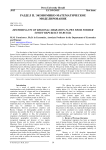
Determinants of regional migration flows from former Soviet republics to Russia
Статья научная
The dissolution of the Soviet Union two decades ago created a new migration situation in the region. Although former Soviet republics develop independently, the region remains a common area for the vast majority of population. The post-Soviet movement of people is facilitated by shared transportation and communication systems, a regionally recognized language (Russian), education systems, complementary labor markets, and similar mentalities and behavior patterns. Russia is an important place of destination for regional migration. This may be attributed to notable income differentiation between former Soviet republics and Russia. Relevant changes of demographic profile in both directions also predict and reflect the patterns and flows of regional movement of people. This paper is aimed at analyzing and identifying factors affecting regional migration flows to Russia. The gravity model, being a key empirical tool, has been utilized in the paper. The research approach to the topic of interest remains interdisciplinary as it incorporates both economic and non-economic factors of migration patterns. The key finding of the paper is that the level of income in source countries and population in places of origin and destination are influential for migration. Socio-cultural factors which reflect a common historical background remain significant in all estimations.
Бесплатно

Economic dynamics models: theory, applications, computer aided implementation
Статья научная
In the paper, a survey of theoretical and applied results obtained in the framework of the scientific school at the Department of Information Systems and Mathematical Methods in Economics, Perm State University, is given. It covers the period from 2008 to 2015. The theoretical results are based on the principal statements of the contemporary theory of functional differential equations worked out by the participants of the Perm Seminar under the leadership of Prof. N.V. Azbelev (1922-2006). The focus of attention is on problems of forecasting, boundary value problems (problems of attainability), control problems, and problems of stability for the dynamic models that allow one to take into account aftereffects and effects of impulse disturbances (shocks). For the mentioned problems, sufficient conditions of the solvability are obtained, methods of constructing program controls and the corresponding trajectories are proposed. Algorithms of the computer-assisted study of the control problems are worked out, including algorithms of correction for certain ill-posed problems. The applied results use the achievements of the theory and are implemented in the form of software tools for the study and solution of the real economy problems such as forecasting, control and stability analysis as applied to models of socio-economic development of the regions of the Russian Federation and the Russian Economy as a whole.
Бесплатно

Статья научная
The task to develop and use economic-mathematical models that increase the speed and quality of decision-making is becoming acute in terms of increasing competition at the banking service market, and in the consequences of the need for permanent increase of economic efficiency of banking institutions. Currently most of the decisions are made by banks in an expert way or on the basis of single calculations of economic efficiency of individual projects taking into account the available statistical data on the dynamics of macroeconomic processes. Problems of this kind are usually implemented on the basis of stochastic economic-mathematical models that are based on the knowledge about the probabilistic characteristics of the simulated parameters. For their construction it is necessary to observe rather harsh conditions on implementation of the above considered processes that it is difficult to realize in practice. Hereby, to solve a multi-criteria optimization management problem of a retail unit of a commercial bank we suggest using dynamic economic-mathematical models that include control actions and a vector criterion of quality. The tools under consideration focus on the increase of efficiency of decision-making in the field of the control of the staff amount, as well as in the sales system of a retail unit of a commercial bank. The stages of the creation of dynamic models and an algorithm for the solution of the vector optimization problem have been worked out. For the solution of the optimization problem of the management of a retail unit of a commercial bank we have made calculations for the set of practical tasks in the software environment Delphi 7. And the results obtained during the calculations have been illustrated. The analysis of the results has been made and the selection of an optimal solution has been explained. The suggested method for the vector optimization is characterized with significant practical application as it can be used as the basis for the development of systems to support management decision-making in various areas of the banking sector. Further works in the field will be devoted to the complication of the suggested tools by expanding the phase vector of the management system of a retail unit of a commercial bank by including additional quality criteria for the implementation of the management process under consideration, as well as through the solution of the problem of dynamic economic-mathematical modeling of the process of optimization of adaptive management of the similar process.
Бесплатно

Статья научная
Under the conditions of exacerbation of the crisis, problems of managing cyclic development of the Russian socioeconomic system are gaining special importance as it is necessary not only to level various crisis tendencies, but also to foster accelerated transition of the system to a new stage of development. The article presents the results of research into the conditions of formation of the resource-based model of economic development in Russia, as well as the problems of the economic environment, which has had an impact on the formation and crisis state of the domestic socioeconomic model of development. Basing on the theoretical and methodological analysis conducted, "supercycles" are defined as an undulatory process of industrialization in large countries causing increase in demand for raw materials. The authors'' model of the nature of a modern supercycle is presented, which allows for predicting the main tendencies in the development of technical and economic processes. Dependence of Russia''s participation in the international division of labour on foreign policy factors is substantiated within a historical context. The problems of efficiency of the state participation in economy under the conditions of operation of agreements on production sharing and formation of the anti-crisis programme are considered. It is shown that preservation of the adverse regularity in placement of factors of production and income from them is of stable nature, and in the age of globalization this relation is only becoming stronger. Therefore, for the purposes of economic security, import substitution policy comes to the fore. Introduction of preferences to the practice of profit taxation for the development of production cooperation on the basis of accounting branch profitability is suggested among the key actions. The authors confirm that there is influence of global economic environment on the choice of a country''s model of socioeconomic development. The phenomenon of "resource curse" has to be realized at earlier stages of the development of a society''s socioeconomic model in the developing countries, which play the role of resource suppliers in the international division of labour, lag behind in technological development, have a weak position within international organizations, have no opportunity to influence economic environment and whose financial and currency dependence on the developed countries is rather high.
Бесплатно
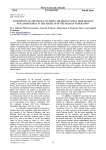
Статья научная
Heterogeneity of socio-economic development of the Russia's regions explains the choice of the research question about studying the differences in the functioning of the regional labor markets in Russia. The elasticities of employment in the regions measured by the value of the gross regional product are more variable than in the whole country. Considering that the low elasticity of employment has traditionally been considered as the main functional feature of the Russian labor market model it shows the peculiarities of the regional labor markets. The goal of this empirical study is to provide the regression analysis in order to identify the influence of the different variables on the number of employees and the number of the labor force in the regions of Russia. The estimations are based on the macro data on regional development, officially published by the Federal State Statistics Service (Rosstat). The choice of variables is based on the analysis of the theory, the approaches used by other authors and the analysis of some indicators of regional economic development. Our results have showed that the labor demand, measured by the number of employees, is affected by the factors that determine the structure of the regional economy. At the same time the labor supply that was estimated by the number of regional labor force depends on the demographic factors. The article explains the impact of the factors on the number of employees and the labor force in the regions. Also there are some conclusions about the functioning of the regional labor markets in Russia that could be explained by the factors with the highest impact.
Бесплатно

Functions and modes of information development of economy: methods and models
Статья научная
Informatization intensification of the modern economy stresses the importance to discuss the following group of issues: 1) the establishment of criteria and measurement of the effectiveness of the information system; 2) the definition of the information potential of the agent and the assessment of effective information action; 3) information security of the social and economic system. The purpose of the study is to analyze theoretically the functions of various types of information with the determination of the efficiency of information and the modes of economic systems information development. Economic agents are known to search for relevant information that is only a part of total information in the system to make efficient decisions. The action of an agent as well as the development of an economic system is generally characterised with an efficiency coefficient that assesses the opportunity to obtain relevant information. The research methodology is the classification method that allows us to highlight the properties of information, to introduce quantitative indicators for measuring these properties and using mathematical tools to determine possible relationships between them, building theoretical models of the dynamics of information development of economy. Using this approach the functions of information, namely, notification, accumulation, cumulative amplification within the framework of consideration of the informational interaction schemes “object-agent” and “agent-agent” have been determined. The criterion of information potential of the controlled system and the information efficiency coefficient have been introduced. The latter means the ratio of information security to the level of information completeness of the system. Using the analysis of the dynamics of the efficiency and the ratio of relevant and general information, the modes of information development of the controlled system have been determined; three options for the accumulation of information with the ability to quantify the effect that determines the development of the knowledge economy have been suggested. Standard, enhanced and storage accumulations have been shown in the framework of the “object-agent” information interaction model, formal parameters for their quantitative assessment have been introduced. We have proved that one of the goals of economic policy should be the insurance of the necessary regime of information development of the economy, that is aimed at solving problems in the field of information security due to the fact that the functions of information can be violated, i. e. performed with different results, which indicates the dysfunction of the information system and economic management. Such the approach will reduce the depth of dysfunctions of economic policy measures and the application of the information security loop proposed by the author will provide the tool for comparing the damage and benefits from possible information threats, which predetermines the practical application of the conducted theoretical analysis applied to different information modes. Sustainable development of the modern economy should consider the elimination of information threats especially in the context of overcoming opportunism in the form of deliberate distortions of information in order to obtain additional benefits. At the same time, the use of the information security loop for the development of economic policy measures will allow not only to diagnose the damage and benefits within the existing information processing regime, but also to identify the dynamics of the economic system development as a result of changes in the ratio of information benefits and costs.
Бесплатно
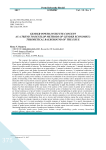
Статья научная
The concept, that analyses economic nature of power relationship between men and women, has been developed on the basis of synthesis of institutional economic theory tools, feminist economics and hierarchical analysis. These power relationships determine the status of men and women in a family and society economy as well as the choice of possible models of behavior. The fundamental issues of the author’s concept are: 1) internal determinacy of dependence of an economic agent-object on an agent-subject; 2) unequal evaluation of resources of a subject and an object of gender power and gender asymmetrical distribution of economic resources; 3) institutional restrictions of hierarchy of gender power distribution are the factor of its reproduction at each level of an economic system; 4) opportunities to realize human capital of men and women are restricted within the limits of institutional roles given by the system of gender power institutes; 5) internal non-coordination of the advanced power disposition reduces the quality of functioning of the whole hierarchical system of gender power institutes and is projected to the level of its interaction with social-economic system in general. The categorical apparatus of feminist economics has been specified and the author has suggested the interpretation of the following categories: gender power, an institute of gender power, institutional role of a subject of gender interaction. The opportunity to apply the postulates of the author’s concept in practice has been demonstrated in the case study of the analysis of the current system of gender power institutes in Russia. The main characteristics of inefficiency of the present system of institutes have been structured. Among them are formal washing out of power borders in macrolevel institutes and strengthening of gender power concentration in microlevel institutes, uniformity of power disposition for subjects, who are at the same hierarchy level, the aims and functions of institutes of different hierarchy level are not coherent, population is not informed enough about forms and facts of gender power manifestation, there are no inverse and horizontal relations among the system elements. The stages to define the strategic imperatives of gender power institutes system of elitist type in modern Russia have been indicated. They are 1) to study peculiarities of possible strategies of institute changes; 2) to specify determinants of quality of gender power institute system; 3) to reveal the nature and to substantiate the importance to change the current system of gender power institutes from the view point of economic agents (men and women); 4) to determine the functioning trajectory and scenario of gender power institutes of elitist type.
Бесплатно

Hierarchical analysis of urban space
Статья научная
Multi-level structure of urban space, multitude of subjects of its transformation, which follow asymmetric interests, multilevel system of institutions which regulate interaction in the "population - business - government -public organizations" system, determine the use of hierarchic approach to the analysis of urban space. The article observes theoretical justification of using this approach to study correlations and peculiarities of interaction in urban space as in an intricately organized system. Hierarchic structure of local communities in urban space is presented, depending on objective function, motivation to integration, level of demand and resources. Several levels of local communities' integration are given out by mesoeconomic analysis. The objective of modeling of local communities, business, authorities and nonprofit organizations as subjects of urban space interconnections and interaction is set. This objective is considered as a novelty, because the existing studies focus on the analysis of regions and gross enterprises. This research focuses on modeling of municipal-level objects' functioning (city) and their correlations with objects of other levels of hierarchy. Level and urban space institutions hierarchy is simulated. Matrix of correlations between the subjects within the transformation of urban space is developed. Two models of urban space development are excreted depending on urban space interactions and correlations, and the qualitative characteristics analysis of these models is presented.
Бесплатно
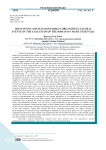
Статья научная
Cultural management is mainly focused on the establishment of efficient organizational solutions or models that contribute to the growth of added values in market economy and to the increase of investment and competitiveness attractiveness of an area. Correspondingly, cultural events can stimulate the development of local communities, improve their image and attract additional investments. Due to this fact and because of a widely applied subject of the cultural management the interest to the publications in the branch has recently increased. The purpose of the study is to reveal main risks in the organization of cultural events to improve the quality of their organization process. The novelty of the investigation concerns the justification of the criteria for organizational risks of cultural events and the definition of factors of management effect that will contribute to high quality of cultural event organization. Five parameters have been determined as the criteria for organizational risk in the research. They are types of risk; factors that may influence the organization of a cultural event; the relationship between the types of risk and the quality of the organization of cultural events; measures, that can be taken to neutralize potential risks; the effectiveness of management measures, that influence the identified risks. The research is based on the expert survey of organizers, administrative staff, volunteers and artists who participated in two festivals. The festivals are similar in aims and features of holding as they both promote Romanian music - Cluj Modern and Trio Transilvan. The research includes economic and statistical methods applied to the analysis of expert survey results. During the expert survey we have revealed that the organizers of the Trio Transilvan festival are somewhat detached about the various negative influences that could affect the development of the event. Insufficient human resources involved in the event organization or their low quality are critical for the festival. The situation when the scope of the event is higher than the expected number of participants is less critical. As for the Cluj Modern festival is concerned, it should be noted that the average values for the five analyzed criteria of organizational risk correspond to the average probability of its implementation. Herewith, risks associated with human resources are high, whereas risks associated with poor quality of event organization is significantly low. In general, the factors of negative impact on the organization of cultural events, performing social and educational missions, are low level of professionalism of the organizers of cultural event, insufficient investment in improving the quality of their human capital, insufficient attention to marketing and financial issues, the lack of a strategy for promoting the event, the invitation of artists, who are partly involved in the show industry. Taking into account the above mentioned information, the studies devoted to the development of theoretical and methodological foundations and practical guides for the integration of organizational risk factors into cultural event management that will consider the features of the national culture in order to improve the quality of their organization, decrease the impact of financial, marketing, information and other restrictions will be promising.
Бесплатно

Статья научная
In modern conditions the economic science still has not developed a unified understanding of the role of health care in the rational organization of the working environment in the enterprise. The purpose of the article is consideration of forming a rational behavior of economic agents at the enterprise level based on the interactions of formal and informal institutions, resulting in a transformation of values in the field of health savings through the application of new knowledge. The hypothesis of the research is the presence of the influence of formal and informal institutions for behavioural installation in the system of health care. The study is based on institutional approach, allowing to identify features of institutional arrangements and value orders of magnitude, considering not only legal and recorded in a formal way rules, how much of the agreement as a set of informal norms, according to which the interaction between people in a particular area of their activities. The novelty of the research is to study the impact of mental models culture of health care to limit the irrational behaviour of employees. On the basis of the systematization of scientific approaches characterized by system of formal and informal institutions that influence the behavior of health care. For experimental confirmation of the hypothesis about the importance of establishing an effective regulatory environment in January-February of 2015, a survey was conducted at the number of industrial enterprises of Perm and Perm region (JSC Saranovskaya Mine Rudnaya, JSC Motovilikhinskiye Zavody, Barma Ltd., Perm Engine company Ltd),. The results of a study of attitudes of employees of enterprises in Perm region allow us to conclude about the existence of cognitive constraints that shape irrational behavior in the field of health.
Бесплатно
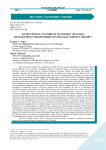
Institutional factors of economic changes: development trajectories of Douglas North's theory
Статья научная
The present article considers the contribution of Douglas North to general institutional economic theory with a special emphasis on the research of institutional factors of economic changes. It has been revealed how agents' interaction models are formed and how institutions influence the agents' behavior and change their models. It is especially important, that D. North's conclusions and their development in modern economic theory result in the emergence of the so-called institutional macroeconomics and being a scientific discipline it explains economic changes on long intervals of evolution. The main emphasis in the article is put on two D. North's works: “Institutions, Institutional Changes and Economic Performance” (1990) and “Understanding the Process of Economic Change” (2005). The advantages and possible disadvantages of the new institutional approach by D. North that is devoted to a long interval of social evolution have been demonstrated. In particular the formal informal institutions relations have been discussed as well as compulsion mechanisms that according to D. North belong to special institutions that play a significant role in the description of institutional changes at long time intervals have been considered. The role of a government and government regulation mechanisms have been studied based on the compulsion mechanisms to observe the rules and norms in economy. We study the connection between transaction and transformation costs that are conventionally considered independently in the frameworks of a new modern institutionalism. The authors' attitude to technologies as special and rather stable institutions at particular time periods has been proven. This attitude is opposite to the view that institutions and technologies are interconnection factors of institutional changes according to D. North. From the authors' point of view the model approach by D. North provides restricted representation of institutional changes of complex social and economic model. Moreover, there is a redistribution of weights of change factors and D. North's theory is not able to determine the regularities in the weights change. In its turn the introduction of the trust factor by G. Akerlof andR. Shiller is not a sufficient decision as different social institutions have macroeconomic importance. These institutions predetermine economy development and trust forms that are formed between some agents. For example, technologies are such institutions and processability of economy as a system predetermines its economic dynamics and demand for the change of some institutions into the others-institutional changes regime. Thus the task under consideration is difficult and has not been solved in economics yet. The opportunity to solve the above mentioned challenges using the postulates of “institutional macroeconomics” as the scientific analysis branch has been founded.
Бесплатно
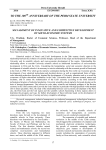
Management of innovative and competitive development of socio-economic systems
Статья научная
Historical analysis of Perm's and Urals' development in the 20th century clearly captures the relationship between the evolution of scientific thought, expressed in the origin and development of Perm State University and its scientific schools, and socio-economic development of the region. Understanding this relationship allows to consider University scientific schools as intellectual locomotives of socio-economic development in Perm and the Urals. Considering the humanitarian, social and economic direction in the development of scientific schools it is necessary to note its relationship with the economic growth in Russia and in the Urals in 1908-1914, which got its intensive continuation during the first world war. Economic growth, development of new electrical technologies and electrical devices, as well as organizational forms of large-scale industrial production objectively required the development of University education and as a result the occurrence of higher educational institutions in the Urals. Universities had to become research centers and incubator, able to ensure the modernization of the Urals' economy according to the third industrial-technological structure of industrial production. University scientific schools started to form and develop on the basis of emerged departments. They allowed to solve many scientific and industrial problems of the Russian economy in the XXth century and to provide the Urals' industry in particular with high-qualified world standard (for its time) specialists. Thus, the study of the relationship between socio-economic development of the Perm city, the Perm Krai and the Ural region and the scientific schools functioning in these regions allows to determine the prospects and ways for further development of these territories based on the development of science as a productive force of society and a key competitive advantage.
Бесплатно
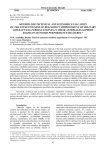
Статья научная
The article describes a conflict between interests of the state customer and the prime contractor on the issue of aeronautical systems and subsystems reliability improvement during its aftersales support. The conflict between interests is shown to arise under the traditional approach to payment for the prime contractor’s services on a basis called “costs+”. Contractual models of public-and-private partnership which are used in the foreign countries successfully, with a payment scheme for the contractor’s services based on outcome performance measures of aeronautical systems and subsystems aftersales support, are presented as a conflict settlement mechanism. A long validity term of such contracts and independence of performance payment amounts from the contractor’s actual expenses motivate the private partner to hold some activities aiming at systems and subsystems reliability improvement. Applicability of technical and economic assessment of these activities is demonstrated. The main provisions of the method for technical and economic evaluation of the effectiveness of aeronautical systems and subsystems reliability improvement are presented thorough the example of a fleet of engines operated within a group of military transport aircrafts with their aftersales support based on outcome performance measures. The method is based on a simulation model of engines fleet operating which allows for the measures of technical and economic evaluation to be identified: average availability of the military transport aircrafts group during the contract validity period, state customer’s operating costs and the prime contractor’s profit. It is experimentally shown on the developed method basis that when the fleet of engines is supported aftersales based on outcome performance measures the prime contractor has an economic interest to improve engines reliability above the requirements specified in the regulatory documentation.
Бесплатно

Micex index forecasting: the predictive power of neural network modeling and support vector machine
Статья научная
The ability to predict the dynamics of financial instruments is an important topic for financial market players. In the context of large and heterogeneous information, there is a need to use effective methods to data processing for management decision-making. In particular, machine learning techniques are becoming very popular in financial modeling. The aim of this paper is to forecast the Russian stock price index by using machine learning methods such as neural network modeling and support vector machine and to examine their predictive power. For economic and mathematical modeling, we use statistical and analytical information on the dynamics of the MICEX stock price index, fundamental and technical indicators of the stock market for the period 2002-2016 years. For computational experiments, we use training, testing and validation datasets and software for machine learning in Python. The predictive power of the methods is estimated on the validation data with using both traditional indicators of mathematical statistics (such as absolute and relative prediction error) and count coefficient of determination. We found the use of a longer time period for the MICEX index that corresponds to large training data set in neural network modeling has led to training error reduction. The predictive power of support vector machine on validation data set is higher comparing with neural network modeling. However, that difference in prediction metrics is not significant. The development of a methodology for filtering input data and trading strategy based on machine learning algorithms are possible directions for further research.
Бесплатно

Статья научная
Over the last decade, an international inflow of remittances throughout the world has increased significantly, becoming the second largest source of foreign financial receipts. It is generally accepted that migrants’ transfers have the potential to benefit recipient countries. The empirical evidence of earlier studies provides controversial conclusions; the literature did not give special attention to the case of the the post-Soviet region. This may be related to the fact that countries of the former Soviet Union did not use to record the relevant data on remittances in their balances of payments. The purpose of this paper is to investigate empirically the role of remittances in economic growth in former Soviet republics for the period of 2002 through 2010, using a panel data set. Our analysis will cover eleven countries, excluding those that do not report data on remittances and Russia. The key finding of the paper reveals that migrants’ transfers do not directly facilitate output growth in former Soviet republics. Migrants act as altruistic individuals and their financial relations with those who remain in places of origin occur under asymmetric information. We admit the fact that our analysis is based upon the official data on remittances that are recorded in countries’ balances of payment. We do not take into consideration unrecorded and informal inflows, which may account for about half of all remittances sent to migrant-sending nations worldwide, and the post-Soviet region is not an exception.
Бесплатно
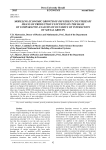
Статья научная
Basing on the theory of endogenous growth, we provide a possible explanation of differences in the development of national economies of the world and their reaction to the global economic crises. Earlier an approach to modeling of the choice of technologies in various countries was proposed (Matveenko, 2007, 2010). Technological progress is modeled as a change of parameter a of the Cobb-Douglas production function Y = AK aL~ a or of the CES production function Y = A(aK p + (1 - a) L p ) 17p. The parameter a has both technological and institutional meaning for the economy, in particular, for the Cobb-Douglas function it is the capital share. Recently, a big difference in capital share in different countries and in different times has been found empirically by several authors. The choice of the parameter naturally depends on the interests of the social groups: the workers and the capital owners; each group agrees to a change of the parameter a if it leads to income increase for this group. Thus, it is possible to identify the areas of coincidence and non-coincidence of interests of the social groups on the plane a-k, where k is the capital-to-labor ratio. Using the UNSTATS statistical data, we build the graphs of parametric dependencies a-k for the economies of the USA, Japan, Russia, China and Iran for the period of 2000 - 2010. The graphs clearly identify the sub-period of the crises by changes in the area of coincidence/non-coincidence of interests. A specific behavior of the integral characteristic for the area of non-coincidence of interests of the social groups in Russia and China is noted, which differs radically from the situation in the USA.
Бесплатно
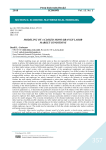
Modeling of a closed mono-branch labor market conditions
Статья научная
Market modeling issues are currently acute as they are responsible for efficient operation of a labor market to achieve full employment and a high rate of economic growth. The aim of the study is to construct a theoretically reasonable closed mono-branch mathematical model that describes the behavior of economic agents at a labor market using a system of differential equations. The model is constructed on the following hypotheses:a market is a closed system with a constant number of the unemployed (applicants) and employees;employees and applicants can be divided into three conventional categories: low-skilled workers the demand for whom is low or absent, the number of these people is equal to the number of vacant positions at an enterprise; average-skilled workers, who may later join to a category of low-skilled or highly qualified workers; highly qualified workers and employers are mostly interested in them. To analyze the dynamic of average-skilled workers the staff training coefficient is implemented to select these employees. Shares of the each category representatives have been chosen as modeling variables. The staff training coefficient, as well as the number of employees and the unemployed and the amount of subjects of each category have been accepted to be constant according to the initial hypotheses. The dynamic of the variables is described by the system of three nonlinear differential equations. Consideration of the system peculiarities makes it possible to find the exact solution of the system in quadratures i.e. to determine the quantitative structure of each of the subjects of the labor market at any moment of time. Particular attention is paid to the asymptotic properties of solutions: the equilibrium points of the system have been found and their stability has been investigated. The research results have revealed that a proactive employer hires highly qualified workers and pays particular attention to human resource policy and it proves the model adequacy. The economic interpretation of the obtained mathematic results in the terms of the initial task has classified possible situations at a labor market and has made a conclusion about the dynamics of each category of the economic agents depending on the initial conditions. Further studies will be devoted to the system complication by including new parameters, e.g. salary impact factor, training costs spent on average- skilled employees, lag, etc. The model may be interesting for both the scholars studying labor market conditions and human resource managers.
Бесплатно

